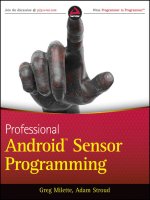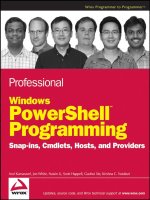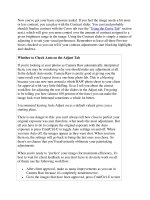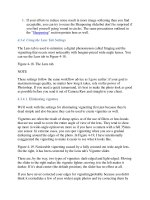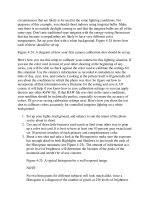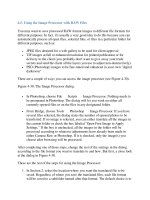professional palm os programming
Bạn đang xem bản rút gọn của tài liệu. Xem và tải ngay bản đầy đủ của tài liệu tại đây (12.09 MB, 961 trang )
Professional Palm OS
®
Programming
01_57373x ffirs.qxd 3/16/05 9:58 PM Page i
01_57373x ffirs.qxd 3/16/05 9:58 PM Page ii
Professional Palm OS
®
Programming
Lonnon R. Foster and Glenn Bachmann
01_57373x ffirs.qxd 3/16/05 9:58 PM Page iii
Professional Palm OS
®
Programming
Published by
Wiley Publishing, Inc.
10475 Crosspoint Boulevard
Indianapolis, IN 46256
www.wiley.com
Copyright © 2005 by Wiley Publishing, Inc., Indianapolis, Indiana
Published simultaneously in Canada
ISBN-13: 978-0-7645-7373-6
ISBN-10: 0-7645-7373-X
Manufactured in the United States of America
10 9 8 7 6 5 4 3 2 1
1B/QU/QU/QV/IN
No part of this publication may be reproduced, stored in a retrieval system or transmitted in any form or by any
means, electronic, mechanical, photocopying, recording, scanning or otherwise, except as permitted under Sections
107 or 108 of the 1976 United States Copyright Act, without either the prior written permission of the Publisher, or
authorization through payment of the appropriate per-copy fee to the Copyright Clearance Center, 222 Rosewood
Drive, Danvers, MA 01923, (978) 750-8400, fax (978) 750-4744. Requests to the Publisher for permission should be
addressed to the Legal Department, Wiley Publishing, Inc., 10475 Crosspoint Blvd., Indianapolis, IN 46256,
(317) 572-3447, fax (317) 572-4355, E-Mail:
LIMIT OF LIABILITY/DISCLAIMER OF WARRANTY: THE PUBLISHER AND THE AUTHOR MAKE NO REP-
RESENTATIONS OR WARRANTIES WITH RESPECT TO THE ACCURACY OR COMPLETENESS OF THE CON-
TENTS OF THIS WORK AND SPECIFICALLY DISCLAIM ALL WARRANTIES, INCLUDING WITHOUT
LIMITATION, WARRANTIES OF FITNESS FOR A PARTICULAR PURPOSE. NO WARRANTY MAY BE CRE-
ATED OR EXTENDED BY SALES OR PROMOTIONAL MATERIALS. THE ADVICE AND STRATEGIES CON-
TAINED HEREIN MAY NOT BE SUITABLE FOR EVERY SITUATION. THIS WORK IS SOLD WITH THE
UNDERSTANDING THAT THE PUBLISHER IS NOT ENGAGED IN RENDERING LEGAL, ACCOUNTING, OR
OTHER PROFESSIONAL SERVICES. IF PROFESSIONAL ASSISTANCE IS REQUIRED, THE SERVICES OF A
COMPETENT PROFESSIONAL PERSON SHOULD BE SOUGHT. NEITHER THE PUBLISHER NOR THE
AUTHOR SHALL BE LIABLE FOR DAMAGES ARISING HEREFROM. THE FACT THAT AN ORGANIZATION
OR WEBSITE IS REFERRED TO IN THIS WORK AS A CITATION AND/OR A POTENTIAL SOURCE OF FUR-
THER INFORMATION DOES NOT MEAN THAT THE AUTHOR OR THE PUBLISHER ENDORSES THE INFOR-
MATION THE ORGANIZATION OR WEBSITE MAY PROVIDE OR RECOMMENDATIONS IT MAY MAKE.
FURTHER, READERS SHOULD BE AWARE THAT INTERNET WEBSITES LISTED IN THIS WORK MAY HAVE
CHANGED OR DISAPPEARED BETWEEN WHEN THIS WORK WAS WRITTEN AND WHEN IT IS READ.
For general information on our other products and services or to obtain technical support, please contact our Cus-
tomer Care Department within the U.S. at (800) 762-2974, outside the U.S. at (317) 572-3993 or fax (317) 572-4002.
Wiley also publishes its books in a variety of electronic formats. Some content that appears in print may not be
available in electronic books.
Library of Congress Cataloging-in-Publication Data
Foster, Lonnon R., 1972-
Professional Palm OS programming / Lonnon R. Foster & Glenn Bachmann.
p. cm.
Includes index.
ISBN 0-7645-7373-X (pbk.)
1. Palm OS. 2. Pocket computers. I. Bachmann, Glenn. II. Title.
QA76.76.O63F597185 2005
004.16—dc22
2005000594
Trademarks: Wiley, the Wiley Publishing logo and related trade dress are trademarks or registered trademarks of
John Wiley & Sons, Inc. and/or its affiliates in the United States and other countries, and may not be used without
written permission. Palm OS is a trademark or registered trademark of PalmSource, Inc. All other trademarks are
the property of their respective owners. Wiley Publishing, Inc., is not associated with any product or vendor men-
tioned in this book.
01_57373x ffirs.qxd 3/16/05 9:58 PM Page iv
About the Authors
Lonnon R. Foster is a programmer and writer who has spent the past nine years creating desktop appli-
cations, database front ends, Web sites, communications software, technical documentation, and hand-
held applications. He has been developing Palm OS applications almost as long as the platform has
existed, starting with his first Pilot 5000 and progressing to more complicated wireless software for
Symbol’s 1700 series. Lonnon fills his sparse free time with tactical tabletop gaming, recreational Perl
coding, and reading everything he can get his hands on.
Glenn Bachmann is a noted author of several books and articles on Palm OS programming and mobile
computing. Glenn is also president and founder of Bachmann Software, a leading provider of wireless
file management, networking, backup, and printing software products for Palm OS, Pocket PC, and
Symbian handheld computing platforms. Founded in 1994, Bachmann Software (
www.bachmannsoft-
ware.com
) has established itself as a leading contributor to the mobile and wireless economy through its
utility software products and partnerships with many of the key companies in the mobile computing
arena. Bachmann’s PrintBoy, FilePoint, Mobile Backup, and Mobile Utilities are among the best-selling
software utilities for handhelds and smartphones.
First and foremost I thank my acquisitions editor, Chris Webb, for remembering me from our previous
collaborations and providing me with the opportunity to participate in writing this book. I also thank
my development editor, Eileen Bien Calabro, who bore the difficult task of keeping the book on track with
just the right amount of poking and prodding to the author.
I also thank Lonnon Foster for creating the phenomenally successful Palm OS Programming Bible,
the second edition of which is the predecessor and foundation of this book. Through Lonnon’s clear and
concise writing style and attention to detail, he has helped programmers around the world become Palm
OS programmers.
There are so many people in the Palm OS developer community—at PalmSource, palmOne, and other
software companies—who continue to be the heroes of our little mobile computing industry. These fine
folks are responsible for the fantastic handhelds, smartphones, operating systems, and software applica-
tions that make it such a delight to participate in and contribute to the success of the Palm Economy.
My hat goes off to you all.
Thanks are also due to the team at Bachmann Software, truly the finest and most dedicated people I
have ever worked with.
Finally, I thank my wife for supporting me in my never-ending adventures in growing a software com-
pany. I also thank my three wonderful children, who seem to have grown up under the impression that
it is entirely normal for their father to possess 58 different handhelds.
01_57373x ffirs.qxd 3/16/05 9:58 PM Page v
01_57373x ffirs.qxd 3/16/05 9:58 PM Page vi
Credits
Executive Editor
Chris Webb
Development Editor
Eileen Bien Calabro
Technical Reviewer
JB Parrett
Copy Editors
Stefan Gruenwedel
Nancy Rapoport
Vice President & Executive Group Publisher
Richard Swadley
Vice President and Publisher
Joseph B. Wikert
Project Coordinator
Erin Smith
Graphics and Production Specialists
April Farling
Carrie A. Foster
Lauren Goddard
Denny Hager
Joyce Haughey
Jennifer Heleine
Lynsey Osborn
Julie Trippetti
Quality Control Technicians
Laura Albert
Amanda Briggs
John Greenough
Leeann Harney
Carl William Pierce
Brian H. Walls
Proofreading and Indexing
TECHBOOKS Production Services
01_57373x ffirs.qxd 3/16/05 9:58 PM Page vii
01_57373x ffirs.qxd 3/16/05 9:58 PM Page viii
In loving memory of Robert B. Hyslop (1909–2002)
01_57373x ffirs.qxd 3/16/05 9:58 PM Page ix
01_57373x ffirs.qxd 3/16/05 9:58 PM Page x
Contents
Introduction xxiii
Chapter 1: The Palm OS Success Story 1
The Palm OS Success Story 1
Comparing Desktop and Handheld Application Design 2
Diversity of Handheld Form Factors 3
Expectation of Performance 3
Limited Input Methods 3
Small Screen Size 4
Processing Power 5
Battery Life 5
Limited Memory 5
RAM as Permanent Data Storage 5
Designing Applications for Smartphones and Other Wireless Devices 6
Many Connection Types 6
Connection Speed 7
Mobile-User Expectations 7
Connection Reliability 7
Connecting to the Desktop 8
Comparing Palm OS Handheld Devices 9
Looking to the Future 10
Summary 10
Chapter 2: Understanding the Palm OS 11
Understanding a Palm OS Handheld’s Power Usage 11
Running Under Different Processors 12
Using Programming Protein 13
Running a Palm OS Application 14
Understanding the Palm OS Garnet Kernel 14
Understanding the Palm OS Cobalt Kernel 15
Responding to Launch Codes 16
Handling Events 16
02_57373x ftoc.qxd 3/16/05 9:42 PM Page xi
xii
Contents
Using Resources 17
Designing an Application’s User Interface 17
Forms 18
Alerts 18
Menus 19
Tables 20
Lists 21
Pop-up Triggers 21
Buttons 22
Repeating Buttons 22
Selector Triggers 23
Push Buttons 23
Check Boxes 23
Sliders 24
Labels 24
Form Bitmaps 25
Fields 25
Graffiti Shift Indicator 26
Scroll Bars 26
Gadgets 27
Following Palm OS User Interface Guidelines 28
Making Fast Applications 29
Highlighting Frequently Used Features 30
Designing for Ease of Use 31
Maintaining Palm OS Style 32
Communicating with Other Devices 37
Serial 37
TCP/IP 37
Bluetooth 38
Telephony 38
IrDA 38
Data Exchange 39
Comparing Palm OS Versions 39
Changes in Version 2.0 40
Changes in Version 3.0 40
Changes in Version 3.1 40
Changes in Version 3.2 41
Changes in Version 3.3 41
Changes in Version 3.5 41
Changes in Version 4.0 42
Changes in Version 5.0 42
02_57373x ftoc.qxd 3/16/05 9:42 PM Page xii
xiii
Contents
Changes in Palm OS Garnet 42
Changes in Palm OS Cobalt 42
Summary 43
Chapter 3: Introducing the Development Tools 45
Using CodeWarrior for Palm OS 46
Familiarizing Yourself with the IDE 47
Changing Target Settings 58
Compiling and Linking in CodeWarrior 61
Using the Palm OS Development Suite (PODS) 62
Familiarizing Yourself with the Eclipse Workbench 63
Changing Project Settings 73
Compiling and Linking in the Eclipse Workbench 74
Summary 75
Chapter 4: Writing Your First Palm OS Application 77
Creating Hello World 1 78
Including Header Files 78
Entering the Application 79
Starting the Application 81
Closing the Application 82
Handling Events 82
Setting Up Forms 85
Responding to Form Events 87
Creating Hello World 2 89
Defining Resource Constants 90
Responding to Form Events 91
Handling Menu Events 93
Displaying Alerts and Using the Text Field 95
Putting It All Together 97
Understanding Changes in Palm OS Header Files 111
Summary 114
Chapter 5: Debugging Your Program 115
Using Palm OS Emulator (POSE) 115
Controlling POSE 118
Running POSE for the First Time 120
Installing a ROM Image 121
Installing Applications 122
Saving and Restoring Configurations 123
02_57373x ftoc.qxd 3/16/05 9:42 PM Page xiii
xiv
Contents
Adjusting Emulator Settings 123
Handling Gremlins 126
Emulating a HotSync Operation 130
Emulating Expansion Cards 132
Capturing Screenshots 133
Handling Errors in the Emulator 133
Using Palm OS Simulator 134
Starting the Simulator 134
Loading a ROM Image 135
Installing Applications and Data 136
Running Gremlins 136
Viewing Databases, Memory, and Events 137
Saving and Loading a Storage Snapshot 139
Debugging at the Source Level 140
Debugging with CodeWarrior 140
Debugging with PODS 143
Resetting a Palm OS Handheld 145
Using Developer Graffiti Shortcuts 146
Using the Palm OS Error Manager 147
Summary 148
Chapter 6: Creating and Understanding Resources 151
Following Palm OS User Interface Guidelines 151
Creating Resources with Constructor 152
Exploring the Project Window 153
Creating Resources with the Palm OS Resource Editor 163
Creating and Editing Application Resources 165
Summary 168
Chapter 7: Building Forms and Menus 169
Building Forms with Constructor 169
Building Menus with Constructor 172
Sharing Menus Between Menu Bars 175
Building Forms with Palm OS Resource Editor 176
Building Menus with Palm OS Resource Editor 178
Understanding Form Object Properties 179
Common Form Object Properties 179
Individual Form and Form Object Properties 181
Introducing Librarian, a Sample Application 190
Displaying Multiple Records in List View 190
Displaying an Individual Book in Record View 191
02_57373x ftoc.qxd 3/16/05 9:42 PM Page xiv
xv
Contents
Editing a Record in Edit View 192
Examining Librarian’s Menus 194
Summary 197
Chapter 8: Programming User Interface Elements 199
Programming Alerts 199
Programming Forms 202
Switching to a New Form 203
Displaying a Modal Dialog Box with FrmDoDialog 203
Displaying a Modal Dialog Box with FrmPopupForm 206
Updating a Form 208
Programming Objects on Forms 210
Handling Form Object Events 211
Retrieving an Object Pointer 213
Hiding and Showing Form Objects 215
Programming Check Boxes and Push Buttons 219
Handling Control Groups 219
Programming Selector Triggers 220
Selecting Dates and Times 221
Selecting Colors 225
Programming Fields 226
Setting a Handle for a Text Field 227
Modifying a Text Field 228
Retrieving Text from a Field 229
Setting Field Focus 230
Setting Field Attributes 231
Programming Gadgets 232
Programming Extended Gadgets 239
Programming Lists and Pop-up Lists 241
Retrieving List Data 241
Manipulating Lists 242
Programming Dynamic Lists 243
Handling Pop-up Lists 245
Programming Menus 247
Hiding Menu Items 247
Programming the Command Toolbar 248
Summary 253
Chapter 9: Managing Memory 255
Managing Memory 255
Palm OS Garnet Memory Architecture 255
Palm OS Cobalt Memory Architecture 259
02_57373x ftoc.qxd 3/16/05 9:42 PM Page xv
xvi
Contents
Using Dynamic Memory in Palm OS Garnet 261
Using Dynamic Memory in Palm OS Cobalt 264
Summary 265
Chapter 10: Programming System Elements 267
Checking for Supported Features 267
Determining the Operating System Version 268
Checking Individual Features 271
Manipulating Text 273
Using Font Functions 273
Using String Functions 284
Using Character Macros 285
Handling Pen Events 289
Handling Key Events 292
Understanding Application Button Presses 294
Overriding Hardware Application Buttons 294
Looking Up Phone Numbers 297
Launching Applications 298
Calling the System Application Launcher 298
Launching Applications Directly 299
Sending Launch Codes Globally 302
Creating Your Own Launch Codes 302
Generating Random Numbers 302
Managing Power 304
Reacting to Low Battery Conditions 306
Identifying the Device 306
Using the Clipboard 307
Summary 310
Chapter 11: Programming Graphics 311
Managing the Drawing Surface 312
Understanding Windows 312
Creating Offscreen Windows 316
Saving and Restoring the Draw State 318
Determining and Setting Color Depth 319
Using Color Tables 323
Translating RGB to Index Values 325
Drawing Graphics and Text 326
Setting the Transfer Mode 326
Setting Foreground, Background, and Text Colors 327
Drawing Pixels 328
02_57373x ftoc.qxd 3/16/05 9:42 PM Page xvi
xvii
Contents
Drawing Lines 328
Drawing Rectangles 329
Drawing Text 332
Drawing Bitmaps 333
Using Color Bitmaps 334
Coloring the User Interface 335
Programming High-Resolution Displays 339
Using the High-Density Display Feature Set 340
Detecting Available Screen Densities 341
Setting and Retrieving the Coordinate System 342
Translating Between Coordinate Systems 343
Using the Palm OS Cobalt Graphics Model 343
What Is a Graphics Context? 344
Understanding Paths 344
Alpha Blending and Anti-Aliasing 344
How Drawing Works in a Graphics Context 345
Summary 347
Chapter 12: Programming Multimedia 349
Understanding Sound Manager 349
Playing Simple Sound 350
Playing Sampled Sound 352
Understanding Multimedia Services 353
Session Objects 353
Working with Sources and Destinations 354
Components of a Playback Session 354
Sample Source Code for Playback 356
Summary 357
Chapter 13: Programming Alarms and Time 359
Setting Alarms 359
Setting an Alarm 360
Responding to Alarms 362
Responding to Other Launch Codes 366
Manipulating Time Values 367
Retrieving and Setting Time Values 368
Converting Time Values 369
Altering Time Values 371
Following User Date and Time Preferences 371
Getting the User’s Attention 374
02_57373x ftoc.qxd 3/16/05 9:42 PM Page xvii
xviii
Contents
Requesting Attention 376
Responding to the Attention Manager 379
Managing Attention Attempts 384
Preventing the Attention Indicator from Appearing 384
Summary 385
Chapter 14: Programming Tables 387
Creating a Simple Table 388
Understanding How Tables Work 388
Initializing a Table 392
Handling Table Events 409
Hiding Rows and Columns 410
Creating More Complex Tables 414
Connecting a Table to Data 415
Scrolling Tables 440
Handling Table Text Fields 461
Summary 468
Chapter 15: Storing and Retrieving Data 469
Understanding Palm OS Databases 469
Understanding Non-Schema Databases 470
Record Databases 471
Resource Databases 473
Working with Non-Schema Databases 473
Working with Extended Databases 488
Working with Schema Databases 488
Storing Application Preferences 492
Reading and Setting System Preferences 496
Using Feature Memory 497
Summary 498
Chapter 16: Manipulating Records 501
Working with Non-Schema Database Records 501
Looking at Records in the Librarian Sample Application 502
Comparing Records 507
Finding Records 513
Creating Records 514
Deleting Records 518
Reading Records 520
Modifying Records 520
02_57373x ftoc.qxd 3/16/05 9:42 PM Page xviii
xix
Contents
Changing Database Structures Between Versions 531
Sorting Records 536
Retrieving and Modifying Record Information 537
Categorizing Records 538
Implementing Private Records 548
Deleting All Private Records 549
Resizing Records 549
Working with Schema Database Records 549
Working with Cursors 550
Implementing the Global Find Facility 555
Handling sysAppLaunchCmdSaveData 556
Handling sysAppLaunchCmdFind 557
Handling sysAppLaunchCmdGoto 561
Summary 564
Chapter 17: Using Secondary Storage 567
Understanding the Expansion Manager 567
Understanding Secondary Storage 568
Organizing Files and Directories 569
Running Applications from Secondary Storage 570
Using the Virtual File System 571
Verifying Presence of the VFS Manager 572
Detecting Card Insertion and Removal 572
Retrieving a Volume Reference 576
Getting and Setting Volume Labels 579
Finding Volume Information 580
Creating Directories 581
Handling VFS Manager Errors Gracefully 585
Creating Files 586
Deleting Files and Directories 589
Opening and Closing Files 593
Retrieving and Setting File Information 595
Reading Data from Files 598
Positioning a File Pointer 603
Writing Data to Files 607
Finding Files 610
Retrieving Default File Locations 613
Dealing with Palm OS Databases 614
Moving Palm OS Databases 615
Summary 615
02_57373x ftoc.qxd 3/16/05 9:42 PM Page xix
xx
Contents
Chapter 18: Sharing Data Through the Exchange Manager 617
Using the Exchange Manager 618
Registering a Data Type 621
Sending Data 626
Customizing the Data Acceptance Dialog Box 649
Receiving Data 654
Displaying Beamed Records 666
Debugging Beaming 666
Sending Applications and Databases 667
Receiving Databases 670
Summary 671
Chapter 19: Using the Serial Port 673
Understanding Palm OS Serial Communications 673
Using the Serial Manager 675
Using the New Serial Manager 677
Using the Old Serial Manager 698
Summary 701
Chapter 20: Communicating Over a Network 703
Understanding TCP/IP Networking 704
Programming the Palm OS Garnet Net Library 705
Retrieving a Net Library Reference 707
Opening the Net Library 707
Resolving Hostnames and Addresses 708
Finding a Service Port 713
Opening a Socket 715
Connecting a Socket 716
Sending and Receiving Data 717
Disconnecting a Socket 720
Closing a Socket 721
Closing the Net Library 721
Using the Palm OS Cobalt Berkeley Sockets APIs 722
Learning More About Sockets 722
Advantages of Using Sockets with Palm OS Cobalt 723
Summary 724
Chapter 21: Learning Conduit Basics 725
Understanding Conduits 726
Stepping Through the HotSync Process 727
02_57373x ftoc.qxd 3/16/05 9:42 PM Page xx
xxi
Contents
Designing Conduits 729
Choosing a Development Path 730
Installing Conduits 731
Installing Conduits Manually 732
Creating Automatic Conduit Installations 735
Logging Actions in the HotSync Log 738
Summary 741
Chapter 22: Building Conduits 743
Using the Conduit Wizard 743
Selecting a Conduit Type 744
Choosing a Handheld Application 745
Selecting a Data Transfer Type 746
Selecting Conduit Features 747
Confirming Class and File Names 748
Implementing Conduit Entry Points 750
Implementing GetConduitInfo 751
Implementing GetConduitName 753
Implementing GetConduitVersion 754
Implementing OpenConduit 754
Implementing Configuration Entry Points 757
Using the Generic Conduit Base Classes 766
Following Generic Conduit Flow of Control 767
Describing the Desktop Record Format 768
Implementing Storage and Retrieval 770
Converting Data to and from CPalmRecord 779
Synching the Application Info Block 789
Using the Palm MFC Base Classes 789
Following MFC Conduit Flow of Control 790
Implementing a Monitor Class 791
Implementing a Table Class 792
Implementing a Schema Class 795
Implementing a Record Class 796
Implementing a Link Converter Class 800
Using the Sync Manager API 803
Registering and Unregistering a Conduit 804
Opening and Closing Handheld Databases 804
Iterating Over Database Records 807
Reading and Writing Records 810
Deleting Records 811
Maintaining a Connection 811
Summary 812
02_57373x ftoc.qxd 3/16/05 9:42 PM Page xxi
xxii
Contents
Chapter 23: Programming Navigation Hardware 813
Programming the palmOne 5-Way Navigation Button 813
Object Focus and Application Focus 814
Understanding Tab Order 814
Handling Navigation Events 814
Detecting the Presence of 5-Way Navigation Buttons 815
Designing Your Forms for 5-Way Navigation 816
Programming the Sony Jog Dial 816
Understanding JogAssist 819
Working Around JogAssist 820
Summary 826
Chapter 24: Odds and Ends 827
Creating Large Applications in Palm OS Garnet 827
Breaking the 32K Barrier 828
Segmenting Applications in Palm OS Garnet 830
Adding Custom Fonts to Palm OS Garnet Applications 835
Creating a Custom Font 836
Creating a User Interface Dynamically 839
Localizing Applications 843
Using the Text and International Managers 843
Using the File Streaming API 850
Opening File Streams 851
Closing File Streams 854
Retrieving File Stream Errors 854
Deleting File Streams 855
Setting Position in a File Stream 855
Reading and Writing File Stream Data 856
Summary 858
Glossary 859
Index 885
02_57373x ftoc.qxd 3/16/05 9:42 PM Page xxii
Introduction
The convenience, power, and ease of use of Palm OS handheld devices make them attractive to a wide
variety of users. More than 35 million Palm Powered handheld devices have found their way into the
shirt pockets of doctors, lawyers, sales personnel, business professionals, and other segments of society
not normally given to using small electronic gadgetry. With more than 320,000 registered developers and
20,000 third-party applications, Palm OS also has proven to be popular with software authors, which is
where this book comes in.
Professional Palm OS
®
Programming is written for the present and future developers of Palm OS applica-
tions. It is designed to help both aspiring and experienced handheld developers master the ins and outs
of creating a full-fledged Palm OS handheld application.
Whether you are a developer for a large organization that is integrating Palm Powered handhelds into
its sales force or a hobbyist who wants to get the most from your organizer, you will find this book to be
a useful guide to creating software for the Palm OS platform.
What This Book Covers
Professional Palm OS Programming shows you how to create applications that run on handhelds and
smartphones from palmOne, Sony, Kyocera, Samsung, and other licensees of Palm OS.
This book specifically covers both Palm OS Garnet and the new Palm OS Cobalt, representing the next-
generation operating system for Palm OS developers. As of this writing, Palm OS Cobalt 6.1 is complete;
however, Palm OS Cobalt–based handhelds have yet to ship. Furthermore, PalmSource Palm OS Cobalt
development tools are being updated. Accordingly, the book focuses on Palm OS Garnet as the standard
handheld operating system and supplements those chapters with Palm OS Cobalt–specific information
where the introduction of Palm OS Cobalt tools, APIs, and concepts is appropriate.
The primary focus of this book is Palm OS development in the C language, using CodeWarrior for Palm
OS Platform, or PalmSource’s PODS as a development environment. Other tools exist for developing
Palm OS applications, but these environments are popular with the largest developer audience and offer
the most complete access to the many features of Palm OS and the handhelds that run it.
03_57373x flast.qxd 3/16/05 9:59 PM Page xxiii
xxiv
Introduction
Whom This Book Is For
This book was written with the experienced C programmer in mind. If you know nothing at all about
Palm OS programming, this book will get you started with the fundamentals, teaching you how Palm OS
works, showing you the tools available for Palm OS development, and providing you with tips to make
your own applications work seamlessly within PalmSource’s programming guidelines.
Even if you already have delved into the world of creating Palm OS applications, you will find this book
a useful resource because it covers almost every aspect of Palm OS development in depth. Palm OS is
multifaceted, and this book can serve as a guide to exploring those parts of the operating system that
you have not yet dealt with.
If you wish to create applications that make use of TCP/IP communications options on appropriately
equipped wireless Palm Powered handhelds, you will need to know the basics of socket programming
and TCP/IP protocols. Similarly, although this book covers how to perform serial communications on
Palm OS, it will not teach you the basics of serial communications.
Conduit programming is a very complex topic and uses a completely different set of tools from those
used for handheld programming. This book provides a basic overview of conduits, as well as a descrip-
tion of the tools used to create them. An in-depth discussion of conduit programming would require a
book in itself, so that subject is beyond the scope of this volume. For those who are interested in con-
duits, conduit programming requires solid knowledge of C++, as well as a working knowledge of creat-
ing desktop applications for either Windows or Mac OS. Palm’s Conduit Development Kit (CDK)
provides tools for writing conduits in Java and Visual Basic (or any other COM-compliant language),
but this book focuses on C++ conduit development.
How This Book Is Structured
Each chapter in this book focuses on a specific area of Palm OS programming. The first eight chapters,
essential reading for programmers new to the Palm OS, introduce readers to the operating system itself,
the development tools, and the basics of creating a simple application. It is critical that new Palm OS
programmers master the information and concepts presented in these chapters before moving on to
more advanced material.
Once the earlier chapter concepts are mastered, for the most part each of the remaining chapters is self-
contained and can be read as a topic unto itself. The following is an overview of what is covered in each
chapter:
❑ Chapter 1, “The Palm OS Success Story, ” introduces the Palm OS platform and discusses design
issues that are generally important for any Palm OS programmer to understand.
❑ Chapter 2, “Understanding the Palm OS” covers the operating system in more depth, including
a historical overview of Palm OS versions up to and including Palm OS Garnet and Palm OS
Cobalt.
❑ Chapter 3, “Introducing the Development Tools,” provides an introduction to using Metrowerks
CodeWarrior and PalmSource’s PODS to create and work with Palm OS programming projects.
03_57373x flast.qxd 3/16/05 9:59 PM Page xxiv


